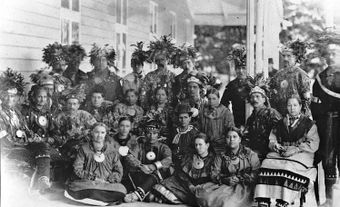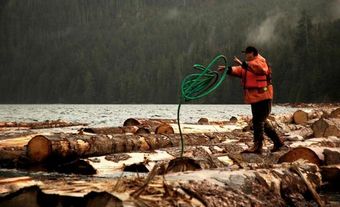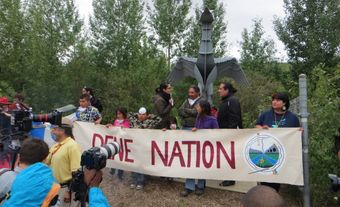The Nicola-Similkameen were an enclave of Athapaskans living in the Nicola and Similkameen river valleys of south-central BC (and, marginally, north-central Washington state), surrounded by Interior Salish. One theory about Nicola-Similkameen settlement in this area suggests they originated from a Tsilhqot'in Athapaskan war party that stayed and intermarried with the Nlaka'pamux and Okanagan Interior Salish in the mid-1700s. Another suggests that the Nicola-Similkameen had a long history in this area, having moved from a more northerly Athapaskan homeland many hundreds of years ago, but archaeological data have not supported this theory.
The few words of Nicola-Similkameen that have been recorded suggest that this language was related to Chilcotin, about 250 km to the north, but analysis of artifacts from archaeological excavations indicates that Nicola-Similkameen Prehistory is closely linked with that of the neighbouring Lillooet, Nlaka'pamux and Okanagan areas. By the early 1900s few people remained who spoke the Nicola-Similkameen language, as it had become secondary to the languages of those who now occupied their territory - the Nlaka'pamux and Okanagan.
The Nicola-Similkameen language is now extinct. The last person who had even a partial knowledge of this language died around 1940. However, there are still some geographical place names both in the Nicola and Similkameen river valleys that are recognized by Interior Salish as being in the Nicola-Similkameen language, and some Nlaka'pamux and Okanagan people are aware of their Nicola-Similkameen ancestry.
Very little information about Nicola-Similkameen culture has been recorded. They, like their Interior Salish neighbours, generally lived in semisubterranean dwellings (pit houses) during the winter and in tule-mat lodges at other times of the year. The Nicola-Similkameen subsisted primarily on lake fishing. Salmon were obtained mainly through trade, as anadromous fish were not available either in the upper Nicola River or along the entire length of the Similkameen River. The Nicola-Similkameen diet was supplemented by elk, deer, small game and vegetal foods.
Nlaka'pamux and Okanagan encroachment into Nicola-Similkameen territory was the result of several factors, perhaps the most important being the introduction of the horse to the Plateau area in the 18th century. The horse extended travel for the purposes of trade and food harvesting, with the result that Nlaka'pamux and Okanagan peoples came to use areas occupied by the Nicola-Similkameen. By the mid-1800s the Nicola-Similkameen were under the influence of the Nlaka'pamux and Okanagan. Epidemic diseases, intermarriage with the Interior Salish and the increasing presence of non-Aboriginal peoples further hastened the demise of the Nicola-Similkameen in the latter half of the 19th century.
See also Aboriginal People: Plateau and general articles under Aboriginal People.

 Share on Facebook
Share on Facebook Share on X
Share on X Share by Email
Share by Email Share on Google Classroom
Share on Google Classroom




